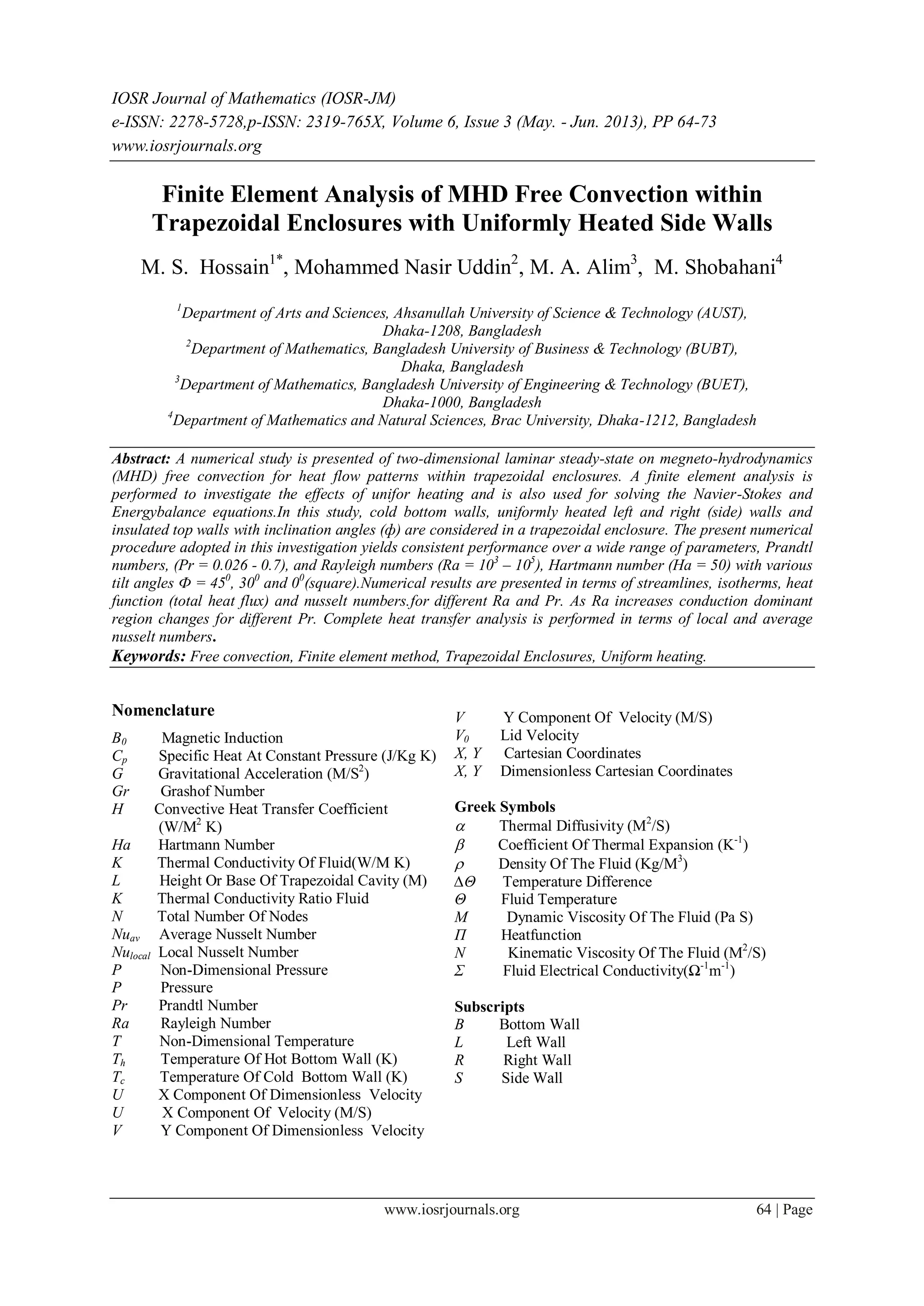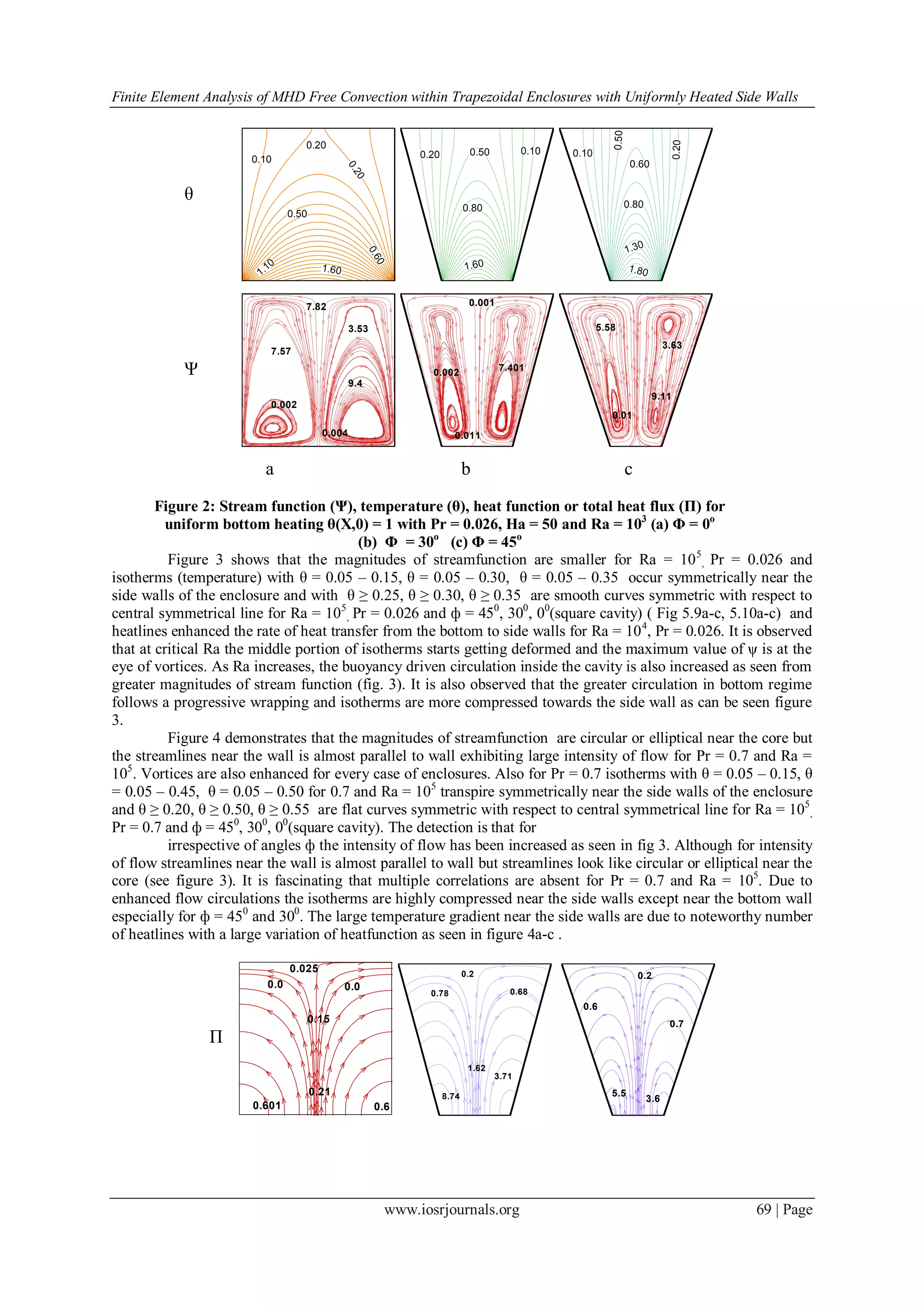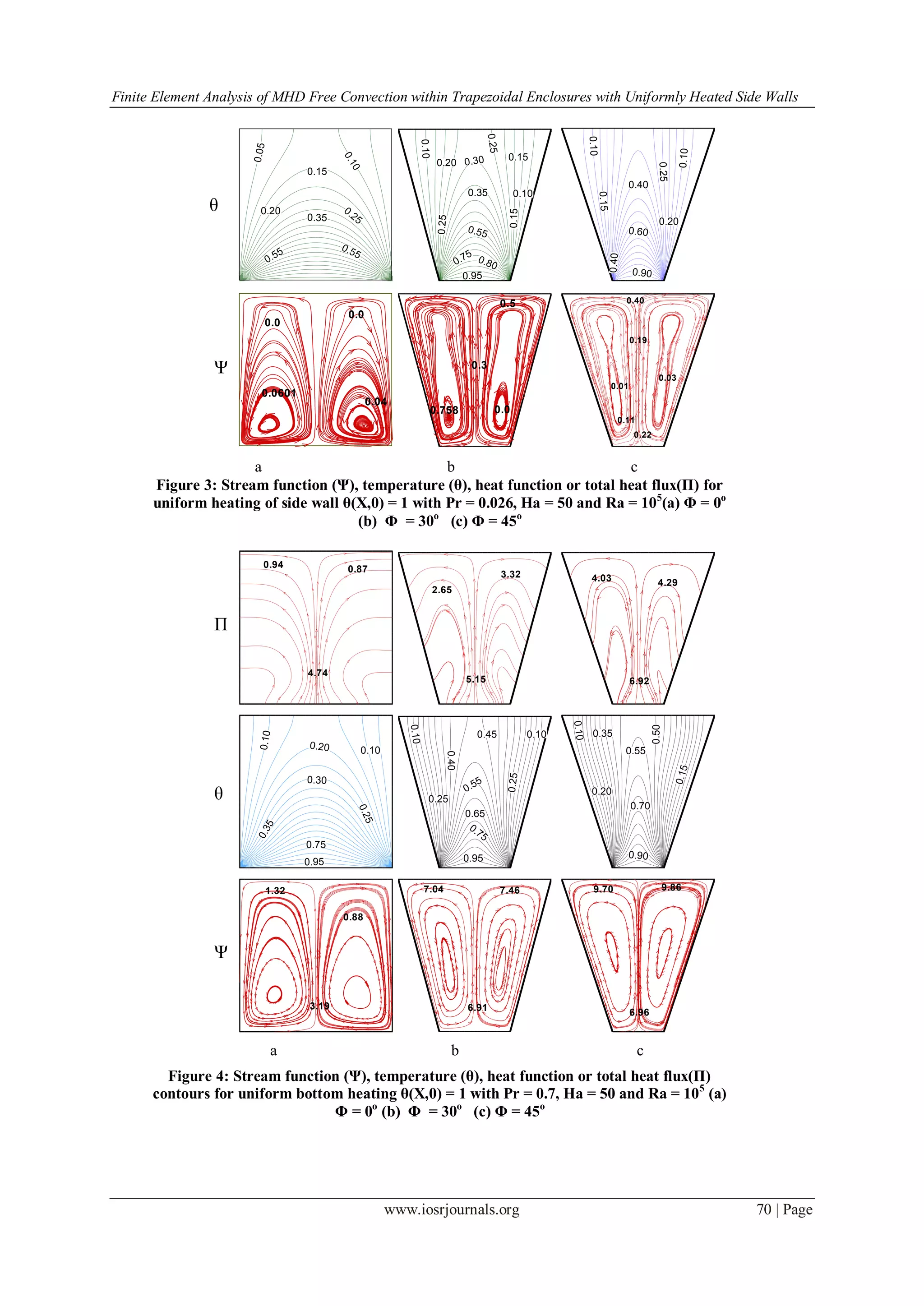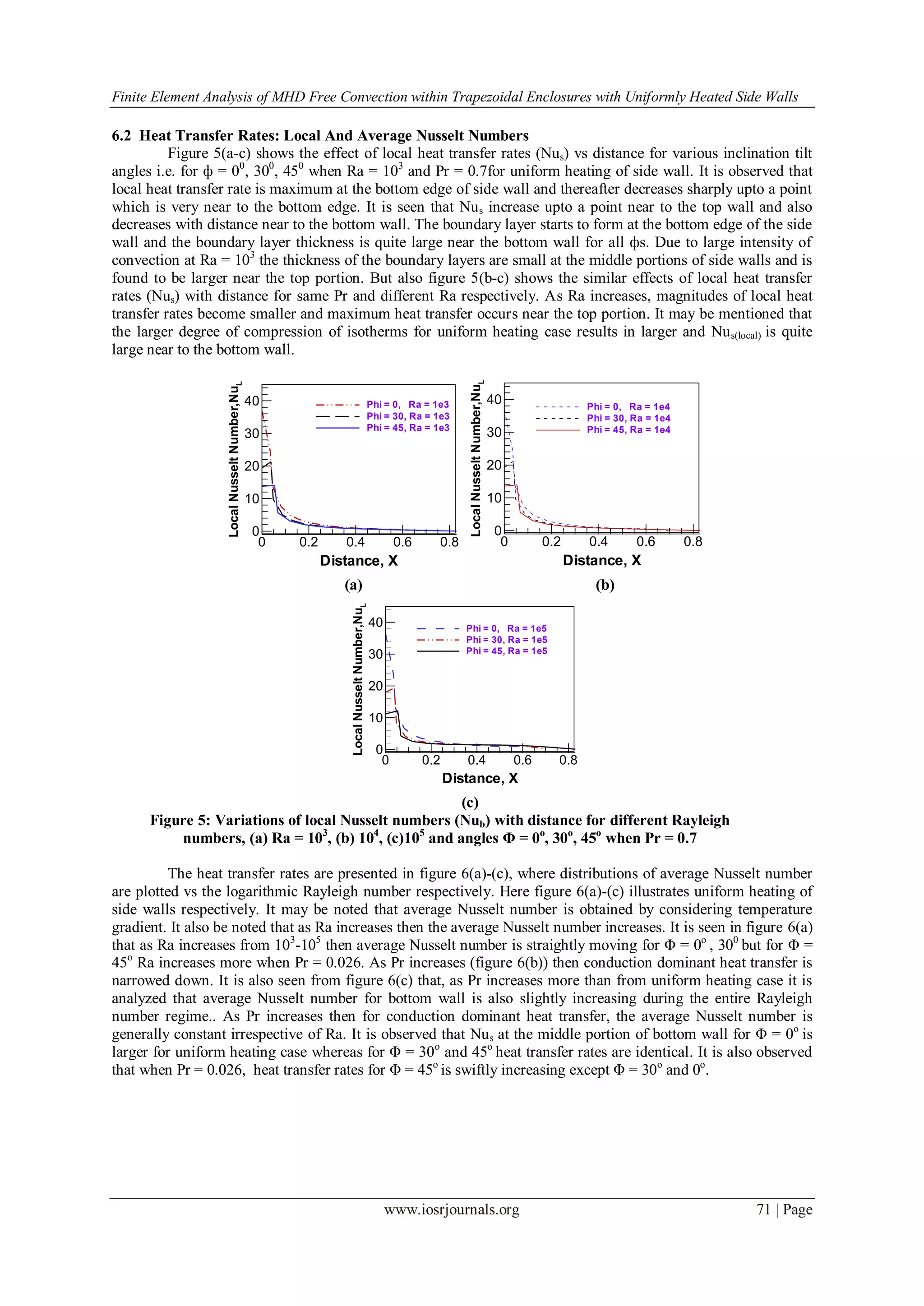This document presents a numerical study on the magnetohydrodynamics (MHD) free convection within trapezoidal enclosures with uniformly heated side walls, using finite element analysis to explore heat flow patterns. It focuses on the effects of various parameters, such as Prandtl and Rayleigh numbers, on heat transfer characteristics depicted in streamlines and isotherms under different conditions. The study indicates significant implications for industrial applications involving heat transfer in complex geometries.

![Finite Element Analysis of MHD Free Convection within Trapezoidal Enclosures with Uniformly Heated Side Walls
www.iosrjournals.org 65 | Page
I. Introduction
The well-known buoyancy driven Phenomena of convection motion of fluid has attracted many
researchers over the past few years. The phenomenon of heat and mass transfer frequently exist in chemically
processed industries such as food processing and polymer production. The phenomenon of free convection flow
involving coupled heat and mass transfer occurs frequently in nature. In these studies the magnetohydrodynamic
phenomenon is applied. Magnetohydrodynamics (MHD) has attracted the attention of a large number of
scholars due to its diversified applications. The study of the effects of magnetic field on free convection flow is
important in liquid-metals, electrolytes and ionized gases. Magnetohydrodynamic flows have applications in
meteorology, solar physics, cosmic fluid dynamics, astrophysics, geophysics and in the motion of earthes core.
Shanker and Kishan [1] presented the effect of mass transfer on the MHD flow past an impulsively started
infinite vertical plate. Elabashbeshy [2] studied heat and mass transfer along a vertical plate in the presence of
magnetic field. However, Free convection in enclosed cavities has received significant attention due to many
engineering applications [3–7]. The extensive studies for rectangular and square enclosures using various
numerical simulations reported by Patterson and Imberger [8], Nicolette et al.[9], Hall et al. [10], Hyun and Lee
[11], Fusegi et al. [12], Lage and Bejan [13,14], Xia and Murthy [15] and Al-Amiri et al.[16]ensure that several
attempts have been made to acquire a basic understanding of natural convection flows and heat
transfercharacteristics in an enclosure. The majority of works dealing with convection in enclosures are
restricted to the cases of simple geometry e.g., rectangular, square, cylindrical and spherical cavities. But the
configurations of actual containers occurring in practice are often far from being simple. A few studies on
natural convection on triangular enclosures filled with a viscous fluid or a porous medium have been carried out
by earlier researchers [17–19]. In recent years, most of the enclosures commonly used in industries are
cylindrical, rectangular, trapezoidal, triangular etc. Trapezoidal enclosures have also received a considerable
attention for their application in various fields.
A comprehensive understanding of energy flow and entropy generation is needed for an optimal
process design via reducing irreversibilities in terms of „entropy generation‟. In this study, analysis on entropy
generation during natural convection in a trapezoidal cavity with various inclination angles (φ = 45°, 60° and
90°) have been carried out for an efficient thermal processing of various fluids of industrial importance
(Pr = 0.015, 0.7 and 1000) in the range of Rayleigh number (103
− 105
) by Basak et. al [20]. Basak et al. [21]
studied a comprehensive heatline based approach for natural convection flows in trapezoidal enclosures with the
effect of various walls heating. The present numerical study deals with natural convection flow in closed
trapezoidal enclosures. Anandalakshmi and Basak [22] studied for the energy distribution and thermal mixing in
steady laminar natural convective flow through the rhombic enclosures with various inclination angles, φ for
various industrial applications. Here simulations are carried out for various regimes of Prandtl (Pr) and Rayleigh
(Ra) numbers. Dimensionless streamfunctions and heatfunctions are used to visualize the flow and energy
distribution, respectively. Basak et al. [23] also investigated the numerical investigation of natural convection in
a porous trapezoidal enclosures for uniformly or non-uniformly heated bottom wall. Penalty finite element
analysis with bi-quadratic elements is used for solving the Navier–Stokes and energy balance equations. The
numerical solutions are studied in terms of streamlines, isotherms, heatlines, local and average Nusselt numbers
for a wide range of parameters Da(10−5
–10−3
), Pr(0.015–1000) and Ra(Ra = 103
–106
). At low Darcy number
(Da = 10−5
), heat transfer is primarily due to conduction for all φ‟s as seen from the heatlines which are normal
to the isotherms. Basak et al. [24] also performed heat flow patterns in the presence of natural convection within
trapezoidal enclosures with heatlines concept. In this study, natural convection within a trapezoidal enclosure
for uniformly and non-uniformly heated bottom wall, insulated top wall and isothermal side walls with
inclination angle have been investigated. Momentum and energy transfer are characterized by streamfunctions
and heatfunctions, respectively, such that streamfunctions and heatfunctions satisfy the dimensionless forms of
momentum and energy balance equations, respectively. Finite element method has been used to solve the
velocity and thermal fields and the method has also been found robust to obtain the streamfunction and
heatfunction accurately. The unique solution of heatfunctions for situations in differential heating is a strong
function of Dirichlet boundary condition which has been obtained from average Nusselt numbers for hot or cold
regimes. Natarajan et. al [25] presented a numerical study of combined natural convection and surface radiation
heat transfer in a solar trapezoidal cavity absorber for Compact Linear Fresnel Reflector (CLFR) . The
numerical simulation results are presented in terms of Nusselt number correlation to show the effect of these
parameters on combined natural convection and surface radiation heat loss.
In the present investigation, visualization of heat flows via heatlines for magneto-hydrodynamics
(MHD) free convection with uniformly heated side walls were reported for trapezoidal enclosures. Results are
obtained to display the circulations and for different physical parameters in terms of streamlines, stream
functions, total heat flux, isotherms and heat transfer rates for the walls in terms of average and local nusselt
numbers.](https://image.slidesharecdn.com/h0636473-150428023742-conversion-gate01/75/Fuzzy-numbers-Nth-order-Fuzzy-Initial-Value-Problems-Runge-Kutta-method-Centroidal-Mean-Lipschitz-condition-2-2048.jpg)

![Finite Element Analysis of MHD Free Convection within Trapezoidal Enclosures with Uniformly Heated Side Walls
www.iosrjournals.org 67 | Page
Here Ha, Ra, Pr, Gr are Hartmann number , Rayleigh number, Prandtl number and Grashof number
respectively. Thermal diffusivity, volumetric thermal expansion coefficient, dynamic viscosity, kinematic
viscosity, electrical conductivity, density and dimensional temperature difference of the fluid are represented by
the symbols α, β, μ, ν, σ, ρ, ΔT, respectively.
2.2 Boundary Conditions
The boundary conditions (also shown in Fig. 1), for the present problem are specified as follows:
At the bottom wall:
0, 0, 1, 0, 0 1U V Y X
At the left wall:
0, 0, 0, cos sin 0, 0 1U V X Y Y
At the right wall:
0, 0, 0, cos sin cos , 0 1U V X Y Y
At the top wall:
0, 0, 0, 1, tan 1 tanU V Y X
Y
where X and Y are dimensionless coordinates varying along horizontal and vertical directions, respectively; U
and V are dimensionless velocity components in X and Y directions, respectively; is the dimensionless
temperature.
The local Nusselt number at the heated surface of the cavity which is defined by the following expression:
l r b sNu Nu Nu Nu
n
,
where n denotes the normal direction on a plane.
The average Nusselt number at the cold bottom wall, uniformly heated left and right (side) walls and insulated
top walls of the enclosures based on the non-dimensional variables may be expressed as,
1 1 1 1
0 0 0 0
l r s bNu Nu dX Nu dX Nu dX Nu dX
.
The non-dimensional stream function is defined as, ,U V
Y X
III. Research Methodology
Finite element analysis is a method to solve differential equations numericallywhich can be applied to
many problems in engineering and scientific fields. Finite element simulation of free convection in a two-
dimensional trapezoidal enclosures has been studied.This research starts from two-dimensional Navier-Stoke‟s
equations together with the energy equation to obtain the corresponding finite element equations.Galerkin‟s
weighted resudal method is applied to discretize the non-dimentional governing equations. Triangular mesh is
used to obtain the solution. Because this type of mesh can be used in any shape of domain .Details of method are
available in Taylor and Hood [26] and Dechaumphai [27].
IV. Grid Independence Test
In order to determine the proper grid size for this study, a grid independence test are conducted with Pr
= 0.7, Phi =450
, Ha=50 and Ra = 105
. The following five types of mesh are considered for the grid
independence test.These grid densites are 1527, 2541, 3573, 4563, 5858 nodes and 216, 365, 527, 668, 864
elements. Average Nusselt numbers at the heated surface study of trapezoidal enclosures are used as a measure
of accuracy of solution. From the table 1, a grid size of 4563 nodes and 668 elements is chosen for better
accuracy.
Table1: Grid Sensitivity Check at Pr = 0.7, Phi = 450
, Ha= 50 and Ra = 105
.
Nodes
(Elements)
1527
(216)
2541
(365)
3573
(527)
4563
(668)
5858
(864)
Nu 1.7517261.747969 1.834902 1.848767 2.050656
Time (s) 4.609 5.672 7.204 8.016 9.625](https://image.slidesharecdn.com/h0636473-150428023742-conversion-gate01/75/Fuzzy-numbers-Nth-order-Fuzzy-Initial-Value-Problems-Runge-Kutta-method-Centroidal-Mean-Lipschitz-condition-4-2048.jpg)
![Finite Element Analysis of MHD Free Convection within Trapezoidal Enclosures with Uniformly Heated Side Walls
www.iosrjournals.org 68 | Page
V. Code Validation
The present numerical solution is validated by comparing the current code results against the numerical
result of Basak et al. [24] for free convection in a trapezoidal cavity for streamlines, isotherms and heatflux. For
three different Rayleigh numbers (Ra = 103
, 104
and 105
), while the prandtl number and angle are fixed i.e. Pr =
0.7 , ф = 450
for uniform heating of side wall, average Nusselt number is calculated. The numerical solutions
(present work and Basak et al. [24]) are in good agreement.
Ra
Average Nusselt Number, ( Nuav )
Present
work
Basak et al. (March
2009)
ф = 450
ф = 450
103
1.672972 1.27778
104
1.842988 1.83453
105
2.797346
2.71105
Table 2: Code Validation For Uniform Heating of Side Wall With Pr = 0.7.
VI. Results And Discussion
In this section we present numerical results for streamlines, isotherms and heat function or heatflux for
different Rayleigh number Ra = 103
- 105
and Prandtl number, Pr = 0.026, 0.7 for the fluid with various angles, ф
= 450
, 300
, 00
. These are shown in figure (2-4). Addition, heat transfer rate for local and average nusselt numbers
have been shown for various values of Rayleigh and Prandtl numbers and angles ф.
6.1 Uniform Heating
Figure 2 shows the effects of streamlines, isotherms and heat function for Rayleigh numbers. Here the
magnitudes of streamfunction and heat transfers are primarily due to conduction at low Rayleigh number.
Isotherms with θ = 0.10 - 0.20 take place symmetrically along side (left or right) walls and with θ ≥ 0.30 are
smooth curves symmetric with respect to vertical symmetrical line for Ra = 103
, Pr = 0.026 and ф = 00
(square
cavity) (Fig. 2a). Again, for Ra = 103
, Pr = 0.026 and ф = 300
the temperature contours with θ = 0.10 – 0.40
come about symmetrically near the side walls of the enclosure and with θ ≥ 0.50 are smooth curves symmetric
with respect to central symmetrical line (Fig. 2b). Also for Ra = 103
, Pr = 0.026 and ф = 450
isotherms
(temperature) with θ = 0.10 – 0.50 arise symmetrically near the side walls of the enclosure and with θ ≥ 0.60 are
smooth curves symmetric with respect to vertical symmetrical line (Fig. 2c).The heatlines or total heat flux or
heat function are shown in panels of fig 2a-c. The heatlines illustrate similar attribute that were observed for
uniform heating cases. Besides, we see that vortices are obtained for streamlines in fig 2a-c.
The interesting message is that at the bottom corner point ф = 00
(square cavity) is superior to ф = 450
and 300
. It is evident that heatlines near the bottom portion of side walls are more dense for ф = 450
and less
dense for ф = 00
(square cavity). The dense heatlines are also indicating enhanced rate of heat transfer from the
bottom to the side walls. Therefore for ф = 450
isotherms with θ = 0.05 – 0.35 are shifted toward the side walls.
It is also observed that at the top portion of the cavity for ф = 450
and 300
heat transfer is higher compressed to
ф = 00
(square cavity) based on value of heatfunction (Π). At the corners of bottom wall as the heat transfer is
quite large, the thermal boundary layer is found to develop near the bottom edges and thickness of boundary
layer is bigger at the top portion of the cold wall signifying less heat transfer to the top portion.
0.48
4.52
1.90
7.03
0.30
4.06
1.65
1.75
0.48
3.62
2.46
1.52
1.27
П
П](https://image.slidesharecdn.com/h0636473-150428023742-conversion-gate01/75/Fuzzy-numbers-Nth-order-Fuzzy-Initial-Value-Problems-Runge-Kutta-method-Centroidal-Mean-Lipschitz-condition-5-2048.jpg)



![Finite Element Analysis of MHD Free Convection within Trapezoidal Enclosures with Uniformly Heated Side Walls
www.iosrjournals.org 72 | Page
(a) (b)
Figure 6: Variations of Average Nusselt Number vs Rayleigh number for (a) Pr =
0.026, (b) Pr = 0.7 and of angles Φ = 0o
, 30o
, 45o
for uniform heating of side wall.
VII. Conclusions
The problem of MHD free convection within trapezoidal enclosures for uniformly heated side wall
with heatlines concept has been studied numerically. Flow and temperature field in terms of streamlines and
isotherms and heat function or total heat flux have been displayed. The results of the numerical analysis lead to
the following conclusions:
Local Nusselt number of uniform heating of side wall is largest at the bottom edge of the side wall and
thereafter that decreases sharply upto a point which is very near to the bottom edge.
The heat transfer rate average Nusselt Number, Nuav increases with the increase of Rayleigh number, Ra,
for uniform heating of side wall.
The maximum rate of heat transfer is obtained for the highest Pr.
Various vortices entering into the flow field and secondary vortex at the vicinity boundary wall and bottom
wall of the cavity is seen in the streamlines.
Acknowledgements
Authors would like to express their gratitude to the Department of Mathematics, Bangladesh University
of Engineering and Technology (BUET) and Department of Arts and Sciences, Ahsanullah University of
Science and Technology (AUST), Dhaka, Bangladesh, for providing computing facility during this work.
References
[1] Lhl Shanker B. and Kishan N., The effects of mass transfer on the MHD flow past an impulsively startedinfinite vertical plate with
variable temperature or constant heat flux, J. Eng. Heat Mass Transfer, 19, 1997, 273-278.
[2] Elabashbeshy E.M.A. , Heat and mass transfer along a vertical plate with variable temperature and concentration in the presence of
magnetic field, Int. J. Eng. Sci., 34, 1997, 515-522. doi:10.1016/S0020-7225(96)00089-4
[3] J.M. Garrpeters, The neutral stability of surface-tension driven cavity flows subject to buoyant forces 1. Transverse and longitudinal
disturbances, Chem. Eng. Sci. 47 (5), 1992, 1247–1264.
[4] L.B. Wang, N.I. Wakayama, Control of natural convection in non- and low-conducting diamagnetic fluids in a cubical enclosure
using inhomogeneous magnetic fields with different directions, Chem. Eng. Sci. 57 (11), 2002, 1867–1876.
[5] I.E. Sarris, I. Lekakis, N.S. Vlachos, Natural convection in a 2D enclosure with sinusoidal upper wall temperature, Num Heat
Transfer A 42 (2002) 513–530.
[6] A. Ousegui, A. Le Bail, M. Havet, Numerical and experimental study of a natural convection thawing process, AIChE J. 52 (12),
2006, 4240–4247.
[7] O.G. Martynenko, P.P. Khramtsov, Free-Convective Heat Transfer, Springer, Berlin, 2005.
[8] J. Patterson, J. Imberger, Unsteady natural convection in a rectangular cavity, J.Fluid Mech., 100, 1980, 65–86.
[9] V.F. Nicolette, K.T. Yang, J.R. Lloyd, Transient cooling by natural convection in atwo-dimensional square enclosure, Int. J. Heat
Mass Transfer, 28 , 1985, 1721–1732.
[10] J.D. Hall, A. Bejan, J.B. Chaddock, Transient natural convection in a rectangularenclosure with one heated side wall, Int. J. Heat
Fluid Flow, 9, 1988, 396–404.
[11] J.M. Hyun, J.W. Lee, Numerical solutions of transient natural convection in a square cavity with different sidewall temperature, Int.
J. Heat Fluid Flow, 10, 1989, 146–151.
[12] T. Fusegi, J.M. Hyun, K. Kuwahara, Natural convection in a differentially heated square cavity with internal heat generation, Num.
Heat Transfer A, 21, 1992, 215–229.
[13] J.L. Lage, A. Bejan, The Ra–Pr domain of laminar natural convection in an enclosure heated from the side, Num. Heat Transfer A ,
19 , 1991, 21–41.
[14] J.L. Lage, A. Bejan, The resonance of natural convection in an enclosure heated periodically from the side, Int. J. Heat Mass
Transfer, 36, 1993, 2027–2038.
[15] C. Xia, J.Y. Murthy, Buoyancy-driven flow transitions in deep cavities heated from below, ASME Trans. J. Heat Transfer, 124, 2002,
650–659.
[16] A.M. Al-Amiri, K.M. Khanafer, Pop I, Numerical simulation of combined thermal and mass transport in a square lid-driven cavity,
Int. J. Thermal Sci., 46(7), 2007, 662–671.
Ra
Nuav
103
104
105
2
4
6
8
Phi = 0
Phi = 30
Phi = 45
Ra
Nuav
103
104
105
2
4
6
8
Phi = 0
Phi = 30
Phi = 45](https://image.slidesharecdn.com/h0636473-150428023742-conversion-gate01/75/Fuzzy-numbers-Nth-order-Fuzzy-Initial-Value-Problems-Runge-Kutta-method-Centroidal-Mean-Lipschitz-condition-9-2048.jpg)
![Finite Element Analysis of MHD Free Convection within Trapezoidal Enclosures with Uniformly Heated Side Walls
www.iosrjournals.org 73 | Page
[17] Y.E. Karyakin, Y.A. Sokovishin, O.G. Martynenko, Transient natural convection in triangular enclosures, Int. J. Heat Mass Transfer,
31, 1988, 1759–1766.
[18] A. Bejan, D. Poulikakos, Natural convection in an attic shaped space filled with porous material, J. Heat Transfer – Trans. ASME,
104, 1982, 241–247.
[19] D. Poulikakos, A. Bejan, Numerical study of transient high Rayleigh number convection in an attic-shaped porous layer, J. Heat
Transfer – Trans. ASME, 105, 1983, 476–484.
[20] Bm, T. Basak, R. Anandalakshmi, Kumar Pushpendra, S. Roy, “Entropy generation vs energy flow due to natural convection in a
trapezoidal cavity with isothermal and non-isothermal hot bottom wall”, Energy, 37, January 2012, 514.
[21] T. Basak, D. Ramakrishna, S. Roy, A. Matta, I. Pop, “A comprehensive heatline based approach for natural convection flows in
trapezoidal enclosures: Effect of various walls heating”, International Journal of Thermal Sciences, 50 (8), August 2011, 1385-1404.
[22] R. Anandalakshmi, T. Basak, “Heat flow visualization for natural convection in rhombic enclosures due to isothermal and non-
isothermal heating at the bottom wall”, International Journal of Heat and Mass Transfer, 55(4), 31 January 2012, 1325 - 1342.
[23] Basak T., Roy S., Matta A. , Pop I., “Analysis of heatlines for natural convection within porous trapezoidal enclosures: Effect of
uniform and non-uniform heating of bottom wall” International Journal of Heat and Mass Transfer, Vol. 53, Issues 25–26, pp. 5947-
5961, December 2010.
[24] T. Basak, S. Roy, and I. Pop, Heat flow analysis for natural convection within trapezoidal enclosures based on heatline concept, Int.J.
Heat Mass Transfer, 52, March 2009, 2471-2483.
[25] S. K. Natarajan, K.S. Reddy, and T. K. Mallick, “Heat loss characteristics of trapezoidal cavity receiver for solar linear concentrating
system”, Applied Energy, 93, May 2012, 523-531.
[26] C. Taylor and P. Hood, , “A Numerical Solution of the Navier-Stokes Equations Using Finite Element echnique”, 1( Computer and
Fluids 1), 73,1973. doi:10.1016/0045-7930(73)90027-3
[27] P. Dechaumphai, Finite Element Method in Engineering, 2nd ed., Chulalongkorn University Press, Bangkok, 1999.](https://image.slidesharecdn.com/h0636473-150428023742-conversion-gate01/75/Fuzzy-numbers-Nth-order-Fuzzy-Initial-Value-Problems-Runge-Kutta-method-Centroidal-Mean-Lipschitz-condition-10-2048.jpg)